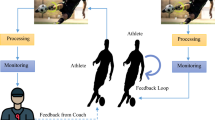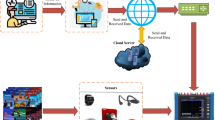Abstract
These days, the integration of big data and information systems enables industries such as sports, health, and medical sciences in resource optimization by enhancing their operational efficiency. Personalized health management, driven by advancements in big data analysis, feature extraction, and internet of things (IoT) has emerged as a prominent trend in the sports industry. Based on these advancements, this paper focuses on leveraging machine vision, big data, and IoT to conduct a comprehensive study for extracting football players' offense features by aiming to improve accuracy and ensure the players’ safety in sports industry. First, this paper discusses a framework for sports health, which is based on big data analysis. Next, we discuss the use of big data and feature extraction for IoT and sports health informatics. The action image of an offense for football players is collected by an intelligent camera, and the gathered imaging code is read and analyzed by radio frequency technology. Using the recognition method of offense action using deep learning and motion information, the offense action’s image features and the three-color features of video RGB are fused into deep learning features to complete the offense action recognition. Based on the offense action recognition, the Harris 3D operator is applied to construct the sequence potential function of the offense action, and the sequence possible function of the offense action is used as the operational technique for this purpose. In addition, the AdaBoost algorithm is used to comprehensively screen the characterized data of athletes' offense actions, and the filtered data are used as training samples to complete the feature extraction of athletes' offense actions. The experimental results show that the proposed method can effectively reduce the recognition error of offense action and improve the efficiency of action’s feature extraction and the accuracy of feature extraction.
Access this article
We’re sorry, something doesn't seem to be working properly.
Please try refreshing the page. If that doesn't work, please contact support so we can address the problem.












Similar content being viewed by others
Data availability
Data are available on reasonable request from the corresponding author.
References
Ali M, Yin B, Kunar A, Sheikh AM et al (2020) Reduction of multiplications in convolutional neural networks. In: 2020 39th Chinese control conference (CCC). IEEE, pp. 7406–7411. https://doi.org/10.23919/CCC50068.2020.9188843
Aslam MS, Qaisar I (2023) Sensor networks with distributed event-triggered scheme for T-S fuzzy system with dissipativity analysis. Eur J Control 71:100800. https://doi.org/10.1016/j.ejcon.2023.100800
Aslam MS, Li Q, Hou J (2021) Fault detection for asynchronous T-S fuzzy networked Markov jump systems with new event-triggered scheme. IET Control Theory Appl 15(11):1461–1473
Aslam MS, Tiwari P, Pandey HM, Band SS (2023) Robust stability analysis for class of Takagi-Sugeno (T-S) fuzzy with stochastic process for sustainable hypersonic vehicles. Inf Sci 641:119044. https://doi.org/10.1016/j.ins.2023.119044
Bilal H, Yin B, Kumar A, Ali M, Zhang J, Yao J (2023a) Jerk-bounded trajectory planning for rotary flexible joint manipulator: an experimental approach. Soft Comput 27(7):4029–4039. https://doi.org/10.1007/s00500-023-07923-5
Bilal H, Yin B, Aslam MS et al (2023b) A practical study of active disturbance rejection control for rotary flexible joint robot manipulator. Soft Comput 27:4987–5001. https://doi.org/10.1007/s00500-023-08026-x
Camargo J, Young A (2019) Feature selection and non-linear classifiers: effects on simultaneous motion recognition in upper limb. IEEE Trans Neural Syst Rehabil Eng 27(4):743–750
Gu Q, Tian J, Yang B, Liu M, Gu B, Yin Z, Yin L, Zheng W (2023) A novel architecture of a six degrees of freedom parallel platform. Electronics 12(8):100. https://doi.org/10.3390/electronics12081774
Gurbuz SZ, Amin MG (2019) Radar-based human-motion recognition with deep learning: promising applications for indoor monitoring. IEEE Signal Process Mag 36(4):16–28
Haiyun Z, Yizhe X (2020) Sports performance prediction model based on integrated learning algorithm and cloud computing hadoop platform. Microprocess Microsyst 79:103322
Khan M, Park HS, Kyung CM (2019) Rejecting motion outliers for efficient crowd anomaly detection. IEEE Trans Inf Forensics Secur 14(2):541–556
Kim J, Chung D, Ko I (2017) A climbing motion recognition method using anatomical information for screen climbing games. HCIS 7(1):1–14
Kim M, Kim K, Wan KC (2018) Simple and fast compensation of sEMG interface rotation for robust hand motion recognition. IEEE Trans Neural Syst Rehabil Eng 26(12):2397–2406
Kumar A, Shaikh AM, Li Y et al (2021) Pruning filters with L1-norm and capped L1-norm for CNN compression. Appl Intell 51:1152–1160. https://doi.org/10.1007/s10489-020-01894-y
Liu G, Luo Y, Schulte O, Kharrat T (2020) Deep soccer analytics: learning an action-value function for evaluating soccer players. Data Min Knowl Disc 34(5):1531–1559
Liu M, Gu Q, Yang B, Yin Z, Liu S, Yin L, Zheng W (2023) Kinematics model optimization algorithm for six degrees of freedom parallel platform. Appl Sci 13(5):100. https://doi.org/10.3390/app13053082
Mi C, Huang S, Zhang Y, Zhang Z, Postolache O (2022) Design and implementation of 3-D measurement method for container handling target. J Mar Sci Eng 10(12):1961. https://doi.org/10.3390/jmse10121961
Nguyen TP, Pham CC, Ha VU (2019) Change detection by training a triplet network for motion feature extraction. IEEE Trans Circuits Syst Video Technol 29(2):433–446
Pappalardo L, Cintia P, Rossi A et al (2019) A public data set of spatio-temporal match events in soccer competitions. Sci Data 6(1):1–15
Patel D, Shah D, Shah M (2020) The intertwine of brain and body: a quantitative analysis on how big data influences the system of sports. Ann Data Sci 7(1):1–16
Patil N, Biswas PK (2018) Global abnormal events detection in crowded scenes using context location and motion-rich spatio-temporal volumes. IET Image Proc 12(4):596–604
Qin X, Liu Z, Liu Y, Liu S, Yang B, Yin L, Liu M, Zheng W (2022) User OCEAN personality model construction method using a BP neural network. Electronics 11(19):3022. https://doi.org/10.3390/electronics11193022
Senst T, Eiselein V, Kuhn A (2017) Crowd violence detection using global motion-compensated Lagrangian features and scale-sensitive video-level representation. IEEE Trans Inf Forensics Secur 12(12):2945–2956
Shao Z, Zhai Q, Guan X (2023) Physical-model-aided data-driven linear power flow model: an approach to address missing training data. IEEE Trans Power Syst. https://doi.org/10.1109/TPWRS.2023.3256120
Wang L, Zhai Q, Yin B et al (2019) Second-order convolutional network for crowd counting. In: Proc. SPIE 11198, fourth international workshop on pattern recognition, 111980T. https://doi.org/10.1117/12.2540362
Wang F, Wang H, Zhou X, Fu R (2022) A driving fatigue feature detection method based on multifractal theory. IEEE Sens J 22(19):19046–19059. https://doi.org/10.1109/JSEN.2022.3201015
Xu J, Pan S, Sun PZ, Park SH, Guo K (2022) Human-factors-in-driving-loop: driver identification and verification via a deep learning approach using psychological behavioral data. IEEE Trans Intell Transp Syst (IEEE-TITS). https://doi.org/10.1109/TITS.2022.3225782
Yao W, Guo Y, Wu Y, Guo J (2017) Experimental validation of fuzzy PID control of flexible joint system in presence of uncertainties. In: 2017 36th Chinese control conference (CCC). IEEE, pp. 4192–4197. https://doi.org/10.23919/ChiCC.2017.8028015
Yin B, Khan J, Wang L, Zhang J, Kumar A (2019) Real-time lane detection and tracking for advanced driver assistance systems. In: 2019 Chinese control conference (CCC). IEEE, pp. 6772–6777. https://doi.org/10.23919/ChiCC.2019.8866334
Zhang Y, Huang Y, Zhang Z, Postolache O, Mi C (2022) A vision-based container position measuring system for ARMG. Meas Control. https://doi.org/10.1177/00202940221110932
Funding
This work was not supported by any funds.
Author information
Authors and Affiliations
Corresponding author
Ethics declarations
Conflict of interests
The authors declare that they have no competing interests.
Additional information
Publisher's Note
Springer Nature remains neutral with regard to jurisdictional claims in published maps and institutional affiliations.
Rights and permissions
Springer Nature or its licensor (e.g. a society or other partner) holds exclusive rights to this article under a publishing agreement with the author(s) or other rightsholder(s); author self-archiving of the accepted manuscript version of this article is solely governed by the terms of such publishing agreement and applicable law.
About this article
Cite this article
Wang, J., Liu, B. Analyzing the feature extraction of football player’s offense action using machine vision, big data, and internet of things. Soft Comput 27, 10905–10920 (2023). https://doi.org/10.1007/s00500-023-08735-3
Accepted:
Published:
Issue Date:
DOI: https://doi.org/10.1007/s00500-023-08735-3




